At The Push Of A Button
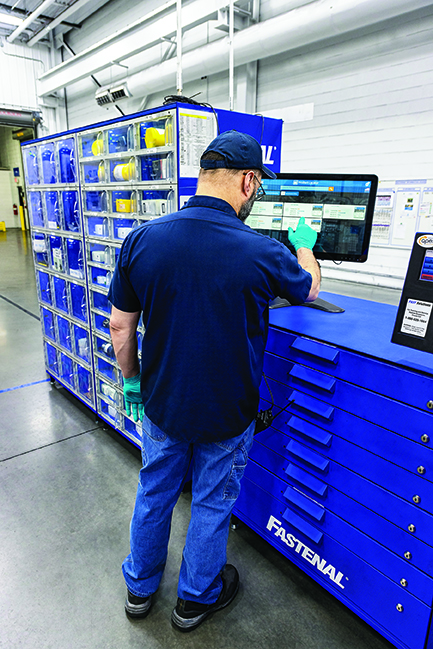 |
| Sensor Machines provide per-item traceability along with 'grab and go' access. The user selects to unlock a cabinet, locker, or drawer, and sensors automatically detect and report the number of items taken by that individual. |
Why vending may be a good option for your own warehouse.
by Kim Phelan
But the part that’s easy to miss is this: What you’re vending and where you’re getting it matters.
 |
| Johnson |
“If your team needs PPE, you don’t want them walking across the facility to get it,” said Johnson. “With vending at the point of use, they have access to what they need to stay on the job and keep productivity high.
“But again, the machines don’t just dispense things – they collect and report data. With the right program, you’re able to gain insight into your inventory – what you have on hand, where, and how much – as well as usage patterns and trends.”
This makes the supply chain more predictable and proactive, he added, and it also illuminates opportunities to make improvements.
Meanwhile, Ben Hill, business development manager at 1 Source Vend, notes that vending programs indeed solve key challenges for both industrial distributors and their customers by offering enhanced inventory management and operational efficiency. They are particularly beneficial where end-users experience high inventory waste or shrinkage, as these systems offer increased security and monitoring.
 |
| Hill |
“In situations with supply flow inefficiencies, such as bottlenecks or the need for excessive personnel for supply distribution, vending systems provide a decentralized supply distribution model, automating item dispensation to employees,” he said. “Crucially, in today’s data-driven environment, these systems deliver detailed analytics, enabling organizations to make informed, metric-driven decisions.”
By addressing these issues, distributors can decommoditize their role, transitioning from mere suppliers to essential solution providers, Hill added. This strategic positioning not only fosters increased customer loyalty and spend but also offers protection against competitive pricing strategies. Moreover, the data collected through vending systems can be leveraged by distributors to refine their operations and improve their service offerings, reinforcing their indispensable value to end-users.
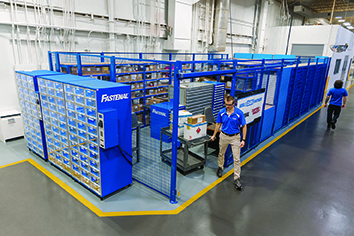 |
| A locker allows the vending of large consumable items and automation of the check-out/return process for assets (tools, scanners, tablets, etc.). It serves as an area to retrieve spot-buy deliveries from Fastenal through its Locker Pickup Program. |
EVALUATING WHAT’S RIGHT FOR YOUR COMPANY
When it comes to important considerations distributors should weigh when evaluating vending products for their own warehouses, Johnson says it can be tough to know where to start, especially if you’re just learning about the possibilities of vending. He recommends the following five steps to make sure you’re ready.
STEP 1 Identify the problems you are trying to fix. By understanding the problems you’re trying to solve, you can determine the right supplier program and machines for your needs.
STEP 2 Choose the right products. Many programs fail due to the wrong product mix, which results in low usage and very little savings. Many suppliers have programs provided at no cost to help you evaluate these needs.
STEP 3 Build the partnership you need. Vending machines are still just machines. And a machine is nothing more than the tool – real savings are achieved when you put that tool to work for you. The software is typically where you are able to review, analyze, and make changes that will lead to continuous improvement.
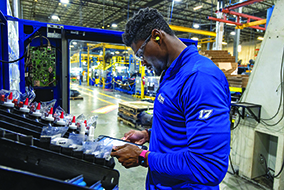 |
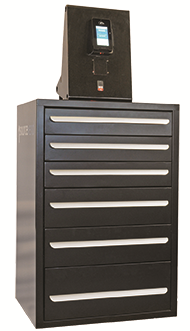 |
| Drawer Units allow easy modification to a drawer's SKU capacity with additional dividers available for order. Drawers utilize both dispense and checkout/return functionality and track drawer access by employee, department, and custom data points with automated reporting. |
|
STEP 4 Set expectations. This is your chance to ask questions. What reporting will you receive? Will your program supplier perform regular reviews? A good partnership is one where continuous improvement exists and both you and your program supplier are able to clearly see results.
STEP 5 Expect results. If things are going well, how do we improve as we continue down that path? But if things need to be fixed, have the tough conversations. Communication around not achieving the expected results can be the key to improving the program and maximizing both opportunities and profits.
One final consideration, Johnson adds: The difference between success and failure often comes down to one simple point. Did you develop a strategic partnership around a program? This partnership should revolve around collaborative discussions on topics like vendor consolidation, inventory management, contract pricing, managing freight costs, and product standardization.
This is how you can take action, and use a tool such as inventory vending, to create a competitive edge to help drive productivity and generate cost savings for your business.
Hill points distributors to focus on software, support, and innovation velocity. The software they use should not only be user-friendly but also scalable to support their business’s growth.
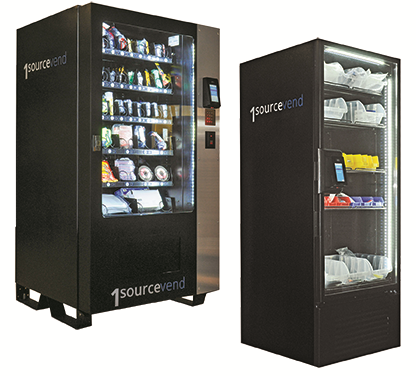 |
| Coil units are ideal for managing large quantities of your most popular consumables. Glassfront units are perfect for managing items that you'd like to dispense in bulk. |
“Evaluate the provider’s support network for its responsiveness and comprehensive coverage, ensuring you have access to a unified support team for both software and hardware issues,” said Hill. “Additionally, consider the provider’s commitment to regularly updating their system and introducing new features or products. Given the rapid evolution of the industrial sector, it’s crucial to partner with a provider capable of adapting quickly to changes, ensuring their solutions remain effective and relevant for years to come.”
WHAT’S NEW?
At 1 Source Vend, Hill says they’re continuously looking for ways to implement distributor feedback into the company’s system enhancements. In the first quarter of 2024, they introduced the second version of their Application Program Interface (API), facilitating extensive data integration between their platform and external systems.
“This enhancement allows users to seamlessly import and export data, such as price updates, directly through their preferred interfaces, significantly reducing manual data entry,” he said. “This update underscores our dedication to providing users with greater data control and scalable solutions.”
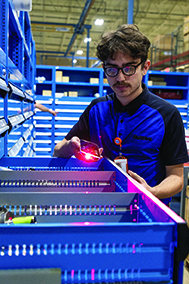 |
“Our software team is continuously updating our platform to improve user experience; right now, we are in the middle of a major site redesign offering an updated UI, multi-language support, and overall enhanced performativity for our users. For hardware, we focus on affordability (low barriers to cost justification), mechanical simplicity (reduced maintenance burden), and modularity (broad range of applications). We’re actively evaluating retail sector technologies that could further align our offering with these principles in a major way. More information will be coming soon.”
Meanwhile, at Fastenal, Johnson says the company is introducing a new mobile app for self-service inventory replenishment ordering.
“We’re also launching a ‘click’ device to simplify replenishment of bulk items (that don’t fit in storage devices) as well as a next-generation scale solution to provide visibility to quantity on hand for bin stock items.
This article originally appeared in the May/June 2024 issue of Industrial Supply magazine. Copyright 2024, Direct Business Media.













